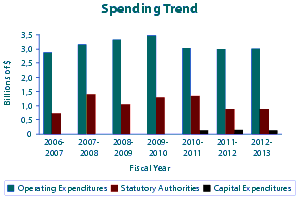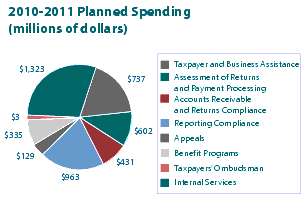Common menu bar links
Breadcrumb Trail
ARCHIVED - Canada Revenue Agency
 This page has been archived.
This page has been archived.
Archived Content
Information identified as archived on the Web is for reference, research or recordkeeping purposes. It has not been altered or updated after the date of archiving. Web pages that are archived on the Web are not subject to the Government of Canada Web Standards. As per the Communications Policy of the Government of Canada, you can request alternate formats on the "Contact Us" page.
Section I: Agency Overview
Message from the Minister

I am honoured to have been recently appointed Minister of National Revenue. I look forward to leading an organization that
has earned the confidence of Canadians through fairness, accountability, and integrity.
Our government is committed to securing the future prosperity of our nation. Implicit in this commitment is the agreement that governments throughout Canada, individual Canadians, and Canadian businesses contribute to our economy by conscientiously fulfilling their fiscal obligations. During the recent period of economic uncertainty, our government's Economic Action Plan (EAP) has helped our country reach our current stage of economic stabilization.
The Canada Revenue Agency (CRA) is playing a key role to the successful implementation of many EAP initiatives like personal income tax relief, an increased Working Income Tax Benefit and the new Home Renovation Tax Credit, as well as other measures targeted to help families, seniors, workers, and persons with disabilities. Through corporate income tax reductions, we are providing support to businesses of all sizes to maintain and create jobs that will strengthen the Canadian economy. To carry out this work, we rely on a world-class tax and benefit delivery system.
While the CRA has been successful in protecting Canada's revenue base, it is clear that there will be future challenges to our ability to do so. Recognizing both our strengths and limitations, our Report on Plans and Priorities 2010-2011 outlines an ambitious agenda that explores existing and anticipated risks and opportunities in greater depth while working for immediate results for Canadians.
As Minister of National Revenue, I am proud to have been given the opportunity to witness the professional and dedicated employees of the Canada Revenue Agency. I look forward to working with this organization in its ongoing pursuit of excellence.
The Honourable Keith Ashfield, P.C., M.P.
Minister of National Revenue,
Minister of the Atlantic Canada Opportunities Agency and
Minister for the Atlantic Gateway
Message from the Commissioner

As the new Commissioner of the Canada Revenue Agency (CRA), I take pride
in becoming a part of such an outstanding public service organization as it embarks on its second decade. I firmly believe
the success of an organization lies in the strength of its employees, and am very aware that
CRA employees have the reputation of serving Canadians with unparalleled
dedication. The progress that has been made over the last ten years has strengthened the
CRA's position as a leader in Canada's public service and a tax administration
that is among the best in the world.
Our 2010-2011 Report on Plans and Priorities builds on our commitment to service excellence anchored by expanded electronic capability. Maintaining our reputation for a high level of performance, however, will be a challenge. Service expectations continue to grow while increasingly sophisticated and elaborate tax avoidance and evasion activities are creating significant compliance pressures. The advancement of our change agenda will necessitate careful stewardship and ongoing investment to maintain our core capacity in service and compliance. We are committed to maintaining service leadership; identifying and addressing key areas of compliance risk; and enhancing the overall fairness and integrity of Canada's tax and benefits system for the immediate benefit of Canadians. In pursuing the priorities set out in this plan, we aim to ensure that individuals and businesses pay the correct amount of tax due and that we deliver, in a timely manner, the exact amount of benefit payments to those Canadians most in need.
I have confidence in our capacity to learn and adapt, and look forward to working with my new colleagues in realizing our goals, making a difference in our country, and making our government proud.
Linda Lizotte-MacPherson
Commissioner and Chief Executive Officer
Canada Revenue Agency
Our Raison d'être and Responsibilities
The Canada Revenue Agency (CRA) is the principal revenue collector in the country and is responsible for distributing benefit payments to millions of Canadians each year.
- provide better service to Canadians;
- offer more efficient and more effective delivery of government programs; and
- foster closer relationships with provinces and other levels of government for which the CRA delivers programs, and providing better accountability.
The CRA contributes to two of the Government of Canada's strategic outcomes:
- Federal organizations that support all departments and agencies; and
- Income security and employment for Canadians.
Our Mandate
The Canada Revenue Agency (CRA) is mandated to administer tax, benefit, and other programs on behalf of the Government of Canada and provincial, territorial, and certain First Nations governments. The CRA exercises its mandate within a framework of complex laws enacted by Parliament, as well as by provincial and territorial legislatures. Our mandate reflects the broad role that we assume in the lives of Canadians.
No other public organization touches the lives of more Canadians on a daily basis than the CRA. Each year, we collect billions of dollars in tax revenue and deliver income-based benefits, credits, and other services that help families and children, low- and moderate-income households, and persons with disabilities. These programs contribute directly to the economic and social well-being of Canadians.
The following two strategic outcomes summarize our contribution to Canadian society.
- Taxpayers meet their obligations and Canada's revenue base is protected; and
- Eligible families and individuals receive timely and correct benefit payments.
In addition to the administration of income tax and benefit programs, the CRA now administers the harmonized sales tax (HST) for three Atlantic provinces. Ontario and British Columbia have also recently entered into agreements with the federal government to implement the harmonized sales tax (HST), which would replace existing provincial sales taxes and the federal goods and services tax in those provinces, beginning on July 1, 2010.
The CRA also verifies taxpayer income levels in support of a wide variety of federal, provincial, and territorial programs, ranging from student loans to health care initiatives. In addition, we provide other services, such as the Refund Set-Off Program, through which we aid other federal agencies and departments, as well as provincial and territorial governments, in the collection of debts that might otherwise become uncollectible.
CRA Program Activity Architecture

Planning Summary
Agency Resources
Alignment to Government of Canada Outcomes
Contribution of Priorities to Strategic Outcomes
The CRA is responsible for administering, assessing, and collecting billions of dollars in taxes annually. We deliver tax services and benefit programs that support the economic and social well-being of Canadians, including families and children, low- and moderate-income households, and persons with disabilities.
The CRA's mandate sets out two strategic outcomes that summarize its contribution to Canadian society. The achievement of these outcomes demonstrates that we are fulfilling our mandate from Parliament.
Taxpayers meet their obligations and Canada's revenue base is protected.
Eligible families and individuals receive timely and correct benefit payments.
We are continually evolving our strategic direction and refining our vision to meet challenges within our changing environment. We have increased our emphasis on mitigating risk factors which may impact our capacity to deliver services to Canadians.
We have introduced five overarching strategic elements to guide our work over the planning period. Our tax and benefit operational and management focus will be on building trust to promote compliance, strengthening service to make compliance easier, making non-compliance more difficult, making it easier to receive the right social benefits, and maintaining business sustainability.
The following table links our priorities to the achievement of our strategic outcomes.
Contribution of Priorities to Strategic Outcomes
Measuring our Strategic Outcomes
Our Operating Environment
Our annual strategic planning process aligns our strategic initiatives with our priorities and risks posed by the operating environment. We begin this process with a review of environmental factors, including business and operating risks, affecting the CRA.
Government Environment
The CRA was instrumental in the recent roll-out of the Government of Canada's Economic Action Plan. Governments at all levels are increasingly using the tax system to deliver very specific social and economic policy objectives. Examples abound, both at the federal, provincial, and territorial levels where interprovincial tax competition is quite fierce. The increasing complexity of the tax system presents a number of challenges for both taxpayers and the CRA.
Public Service renewal remains the top management priority for the Clerk of the Privy Council, with the focus shifting to include seasoned public servants as well as new recruits. The Clerk has also asked deputy heads to embrace more technology in the workplace and to allow employees to take informed risks with the guidance of sound risk management frameworks.
Economy
Canada weathered the recent economic downturn more successfully than other industrialized countries. After a contraction of over 3% in real GDP between the second quarter of 2008 and the third quarter of 2009, there have been some signs of stabilization in the fragile Canadian economy. Forecasts for GDP recovery in Canada during 2010 vary; the Conference Board of Canada suggests an increase of less than 1%, while the TD Financial Group forecasts a 2.7% rise.
Overall, federal tax revenues were down by over 13% during the first seven months of 2009-2010. The Minister of Finance is forecasting a $55.9 billion budget deficit in 2009-2010. Federal budget deficits are projected until at least 2014-2015.
Demographic Trends
Experts believe that while the current recession will result in a short-term surplus of workers, the expected economic upturn as we move into the new decade will again evoke a crises of skilled labour shortages as a decline in the size of the Canadian workforce is forecast to begin in the next ten years.
New Canadians currently account for 70% of recent labour force growth and the participation rates of Aboriginal peoples and women have also been steadily increasing, adding to the diversity of the labour market. It is critical that we deliver information services that new citizens can understand and use, and that help build trust in the CRA.
Like most other large public and private sector organizations, the CRA will be faced with ongoing challenges in our ability to attract, develop, and retain talent. As we look to replace retired workers, we will compete with other organizations for skilled and educated individuals in a shrunken labour pool. These challenges will become more pronounced as we progress through this demographic shift in the coming years.
Technological Change
Sixty-one per cent of Canadians have reported being online for five years or more. This level of use plus emerging social networking technologies leads to increasing client expectations for fast and secure electronic services. The next frontier for the CRA will be wireless technology. In fact, the United States Internal Revenue Service has recently announced that they will offer a tax filing option this year that uses wireless technology. Canadians will expect no less. We will need to assure ourselves that they can do so in an absolutely secure manner to protect their tax information.
When IT service delivery models begin to shift with the emergence of cloud computing, we must determine an appropriate response. Although there are cost advantages to the cloud environment (that is, clients do not own the physical infrastructure and only pay for the resources that they use), the speed and scale of adoption of this model will be tempered by security and privacy considerations.
Corporate Risks
Our Corporate Risk Inventory (CRI) 2009 identifies 14 risks that could negatively affect our ability to meet our business objectives. The CRI is the result of the CRA's second formal effort to understand and assess its key corporate risks. The business and operational risks identified in the CRI and described below are used by senior management to inform our strategic planning process. Many of the risks identified in the CRI are referenced throughout this plan.
Business Risks
The Underground Economy
Aggressive Tax Planning
Willful Non-Compliance
Payment Non-compliance
Operational Risks
Compliance with Various Legislation, Regulations, and Policies
Resource Optimization
Organizational Responsiveness and Resilience
Clients, Stakeholders, Taxpayers, and Benefit Recipients' Expectations
Human Resources Capacity and Capability
Knowledge Management
Employee Ethical Conduct
Protection of Information
Information Technology Responsiveness
Information Technology Sustainability
Expenditure Profile
In the table below, for the period 2006 - 2007 to 2009 - 2010, total spending amount includes all Parliamentary appropriations and revenue sources: Main Estimates, Supplementary Estimates, funding associated with the increased personnel costs of collective agreements, maternity allowances and severance payments, as well as funding to ensure early implementation of Budget 2009 initiatives and the Agency's carry forward adjustments from the prior year. It also includes spending of revenues received through the conduct of CRA's operations pursuant to Section 60 of the Canada Revenue Agency Act, Children's Special Allowance payments, payments to private collection agencies pursuant to Section 17.1 of the Financial Administration Act and payments to the provinces under the Softwood Lumber Products Export Charge Act, 2006. For the period 2010 - 2011 to 2012 - 2013, planned spending excludes carry forward adjustments which are only finalized once Public Accounts are completed and it also does not include any amounts for maternity allowances and severance payments. Finally, for the period 2011 - 2012 to 2012 - 2013 planned spending amounts do not yet include a forecast for payments to the provinces under the Softwood Lumber Products Export Charge Act, 2006 (estimated at $479M in 2010 - 2011).
Since 2006 - 2007, the Canada Revenue Agency's Operating Expenditures reference levels have increased primarily as a result of: collective agreements / contract awards; policy and operational initiatives arising from various Federal Budgets and Economic Statements; the transfer from the Department of Public Works and Government Services Canada for accommodations and real property services; and the assumption of the responsibilities related to the Corporate Tax Administration for Ontario, and the Softwood Lumber Agreement.
The increases to the Operating Expenditures have been offset by a number of reduction exercises, including the 2008 Federal Budget strategic review reductions and the procurement reform cost efficiency savings announced in the 2007 Federal Budget as well as the introduction of the Capital Expenditures Vote in 2010 - 2011.
The Agency Statutory Authorities have fluctuated over the course of the 2006 - 2007 to 2012 - 2013 period as a result of: adjustments to the Children's Special Allowance payments for eligible children in the care of specialized institutions; adjustments to the rates for the contributions to employee benefit plans; increases to the spending of revenues received through the conduct of operations pursuant to Section 60 of the Canada Revenue Agency Act; the introduction from 2007 - 2008 to 2009 - 2010 of payments to private collection agencies pursuant to Section 17.1 of the Financial Administration Act; and finally, the introduction in 2006 of payments to the provinces under the Softwood Lumber Products Export Charge Act, 2006.


Voted and Statutory Items
The Canada Revenue Agency's (CRA) increase in net spending of $88.5M or 2% is due to an increase in operating costs of $39.9M, an increase in contributions and other transfer payments of $54.0M, offset by an additional $5.4M in expected revenue due to an increase in Canada Pension Plan (CPP) and Employment Insurance (EI) recoveries. In addition, the establishment of a new capital authority results in the transfer of $136.1M from operating costs to the new Capital Vote.
- $50.0M related to the payments to provinces under the Softwood Lumber Products Export Charge Act, 2006;
- $24.7M related to Collective Agreements;
- $22.7M related primarily to the transfer from Public Works and Government Services Canada for the increased charges for accommodation and real property services;
- $22.1M in initiatives administered on behalf of Service Canada and the Province of Ontario on a cost recovery basis;
- $9.6M related to 2009 Federal Budget measures such as: Home Renovation Tax Credit, First-Time Home Buyers Tax Credit and Late Filing and Incorrect Format Penalties;
- $4.0M in payments under the Children's Special Allowance Act (CSA) for eligible children in the care of specialized institutions.
- $12.7M related to the Corporate Tax Administration for Ontario;
- $10.2M related to various initiatives announced in the 2007 and 2008 Federal Budgets;
- $9.4M related to the 2008 Federal Budget strategic review reductions;
- $6.2M related to the procurement reform cost efficiency savings announced in the 2007 Federal Budget;
- $6.0M for government advertising programs;
- $0.1M related to other technical adjustments.
